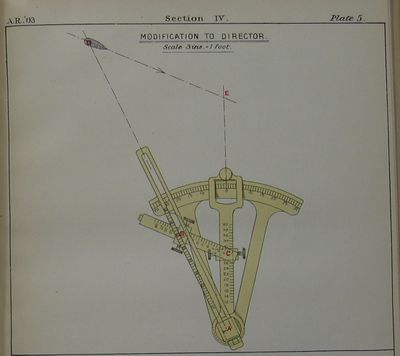Difference between revisions of "Torpedo Director Pattern 1193"
(Created page with 'thumb|400px| Graduated sighting bar for range determination, pp 47-48 Sight is 1193 (as it has sight bar graduations) The '''Torpedo Director Patter…') |
|||
| Line 1: | Line 1: | ||
| − | [[File:ARTS1903Plate5.jpg|thumb|400px| Graduated sighting bar for range determination, pp 47-48 Sight is 1193 (as it has sight bar graduations)]] | + | [[File:ARTS1903Plate5.jpg|thumb|400px| Graduated sighting bar added in 1903 for range determination<ref>''The Annual Report of the Torpedo School, 1903'', Plate 5. Small chance this is 1895 or 2390.</ref>, pp 47-48 Sight is 1193 (as it has sight bar graduations)]] |
| − | The '''Torpedo Director Pattern 1193''' was a British torpedo director used in early torpedo craft | + | The '''Torpedo Director Pattern 1193''', sometimes called the "Right Ahead" director,<ref>''Handbook of Torpedo Control, 1916'', p. 16.</ref> was a British [[Torpedo Director|torpedo director]] used in early torpedo craft. It was used for torpedoes fired from fixed tubes and from dropping gear.<ref>''Torpedo Drill Book, 1905'', p. 376.</ref> |
| − | + | Presumably, it was a contemporary instrument to the [[Torpedo Director Pattern 1192|Pattern 1192]] whose semi-circular design was amenable for use with trainable torpedo tubes.{{INF}} | |
| + | |||
| + | ==Design== | ||
| + | It featured a 60 degree arc and was originally graduated to permit enemy speeds of zero to 30 knots and torpedo speeds of 12 to 40 knots. | ||
If a Pattern 1193a existed, it was similar, but made stronger in its pivots and sighting bar.<ref>''Torpedo Drill Book, 1914'', p. 564.</ref> | If a Pattern 1193a existed, it was similar, but made stronger in its pivots and sighting bar.<ref>''Torpedo Drill Book, 1914'', p. 564.</ref> | ||
| − | In 1903, | + | ==Alterations and Service== |
| + | It entered service sometime before 1903 and was no longer used in any modern ships as of 1912.<ref>''Torpedo Drill Book, 1912'', p. 494.</ref> | ||
| + | |||
| + | In 1903, it is likely that the sight bar was etched with a scale to permit maximum range for firing to be calculated by arithmetic.<ref>''Torpedo Drill Book, 1903'', Plate 5.</ref> | ||
| − | + | In 1909, some were fitted with [[Tangent Bar|tangent bars]] and regraduated to 2/3rd scale for use from TBD fore bridges and heater torpedoes.<ref>''The Annual Report of the Torpedo School, 1909'', p. 22.</ref> | |
==See Also== | ==See Also== | ||
| − | *[[Torpedo Director]] | + | *[[Torpedo Director Pattern 1192]] |
==Footnotes== | ==Footnotes== | ||
Revision as of 17:38, 26 March 2011

The Torpedo Director Pattern 1193, sometimes called the "Right Ahead" director,[2] was a British torpedo director used in early torpedo craft. It was used for torpedoes fired from fixed tubes and from dropping gear.[3]
Presumably, it was a contemporary instrument to the Pattern 1192 whose semi-circular design was amenable for use with trainable torpedo tubes.[Inference]
Design
It featured a 60 degree arc and was originally graduated to permit enemy speeds of zero to 30 knots and torpedo speeds of 12 to 40 knots.
If a Pattern 1193a existed, it was similar, but made stronger in its pivots and sighting bar.[4]
Alterations and Service
It entered service sometime before 1903 and was no longer used in any modern ships as of 1912.[5]
In 1903, it is likely that the sight bar was etched with a scale to permit maximum range for firing to be calculated by arithmetic.[6]
In 1909, some were fitted with tangent bars and regraduated to 2/3rd scale for use from TBD fore bridges and heater torpedoes.[7]
See Also
Footnotes
- ↑ The Annual Report of the Torpedo School, 1903, Plate 5. Small chance this is 1895 or 2390.
- ↑ Handbook of Torpedo Control, 1916, p. 16.
- ↑ Torpedo Drill Book, 1905, p. 376.
- ↑ Torpedo Drill Book, 1914, p. 564.
- ↑ Torpedo Drill Book, 1912, p. 494.
- ↑ Torpedo Drill Book, 1903, Plate 5.
- ↑ The Annual Report of the Torpedo School, 1909, p. 22.
Bibliography